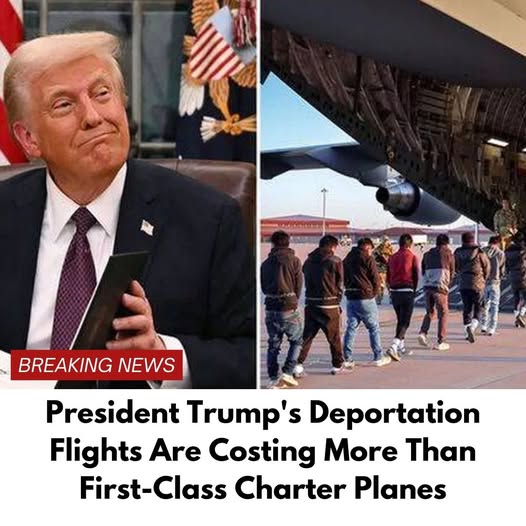Here’s a detailed news article based on the image:
Trump’s Deportation Flights Cost More Than First-Class Charter Planes, Raising Controversy
Washington, D.C. – The U.S. government’s deportation program under President Donald Trump has come under scrutiny after reports revealed that the cost of deportation flights is exceeding the price of first-class charter planes. The revelation has sparked debate over immigration policies, budget priorities, and the overall efficiency of federal spending.
The Rising Costs of Deportation Flights
According to government records and investigative reports, deportation flights—used to remove undocumented immigrants from the U.S. to their home countries—have been costing taxpayers an exorbitant amount, sometimes reaching tens of thousands of dollars per passenger. These flights, operated by government contractors or chartered aircraft, have been used to transport detainees to various countries, including Mexico, Central America, and even destinations as far as Africa and Asia.
A recent analysis showed that some deportation flights were costing between $10,000 and $25,000 per person, a price tag that rivals or surpasses luxury international first-class flights on commercial airlines. In some cases, flights with fewer passengers onboard have been reported to cost even more, as empty seats do not reduce the operational expenses of the chartered planes.
Why Are Deportation Flights So Expensive?
Several factors contribute to the high costs associated with deportation flights:
- Security Measures: Deportees are often accompanied by federal immigration agents, requiring additional seats on flights. The presence of security officers ensures compliance but adds to the overall expense.
- One-Way Flights: Unlike commercial flights, these charters are often one-way trips, meaning the return journey of the aircraft is empty, increasing the per-passenger cost.
- Limited Flight Options: Some deportations require non-stop flights to remote locations, making commercial travel impossible and necessitating expensive private aircraft services.
- Government Contracting Costs: Critics argue that the contracts signed with private charter companies may not be negotiated efficiently, leading to inflated prices that benefit contractors at the expense of taxpayers.
Political and Public Reactions
The reports have sparked a political debate over whether the costs associated with deportation flights justify their effectiveness. Supporters of President Trump’s immigration policies argue that these removals are essential for national security and the enforcement of immigration laws. “Deportation is a necessary expense,” one administration official stated. “Ensuring that individuals who violate immigration laws are returned to their home countries is part of maintaining order.”
However, critics—including immigration rights activists and some fiscal conservatives—question the efficiency of spending such large sums on deportations. “It’s outrageous that the government is spending more on deportation flights than it would cost to fly these individuals in first class on a commercial airline,” said one immigration policy expert. “If this administration truly cares about reducing government waste, they should reconsider how these flights are handled.”
Comparisons to Past Administrations
Deportation flights have been a longstanding practice under multiple administrations, but recent data suggests that costs have escalated significantly during Trump’s tenure due to an increased focus on mass deportations. Under the Obama administration, deportation numbers were also high, but efforts were made to prioritize cost efficiency through commercial airline agreements and larger-scale removal operations.
The Trump administration’s more aggressive stance on immigration enforcement, coupled with logistical challenges posed by the COVID-19 pandemic and diplomatic restrictions with certain countries, has driven costs even higher.
Calls for Reform
With mounting concerns over government spending and immigration enforcement policies, lawmakers are calling for a reassessment of deportation flight procedures. Some have proposed alternatives, such as expanding commercial airline partnerships, reducing security expenses for low-risk deportees, or using alternative forms of transportation when feasible.
Additionally, some advocates are pushing for reforms to the overall immigration system, arguing that a more streamlined legal process for undocumented immigrants would reduce the need for expensive deportation operations.
What Comes Next?
As the debate over deportation costs continues, Congress may investigate how taxpayer money is being spent on these flights. The Department of Homeland Security (DHS) and Immigration and Customs Enforcement (ICE) have yet to respond to demands for greater transparency regarding flight expenses.
For now, the controversy surrounding the high costs of deportation flights adds another layer to the ongoing debate over immigration policy in the United States.
Stay tuned for updates as more details emerge.
Would you like any changes or additional details?


